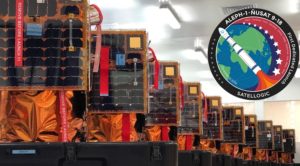
Satellogic launches 10 satellites to provide high-resolution imagery (Image Credit: SNN)
WASHINGTON — With the successful launch of 10 satellites, Earth observation company Satellogic says it can now move ahead of its rivals in providing high-resolution imagery.
A Long March 6 rocket lifted off from the Taiyuan Satellite Launch Center at 10:19 p.m. Eastern Nov. 5 and successfully deployed 13 satellites into a sun-synchronous orbit. The primary payload on the launch was a set of 10 NuSat imaging satellites for Buenos Aires-based Satellogic.
The 10 satellites bring the company’s constellation to 21 satellites, 14 of which provide high-resolution imagery. That constellation, the company said, can provide four million square kilometers of high-resolution images per day at resolutions as sharp as 70 centimeters, including the ability to revisit locations up to four times per day.
“We’ll have essentially more capacity for high-resolution data collection in orbit than any other company in the planet,” claimed Emiliano Kargieman, chief executive of Satellogic, in an interview, putting the company ahead of Maxar and Planet.
Satellogic sees significant demand, particularly from government customers, for that imagery. “There is already a lot of unsatisfied demand for high-resolution imagery,” he said. “The capacity for data collection today that exists in orbit is not enough to supply the needs of current customers. It’s a supply-limited market.”
The pandemic has stimulated additional demand for that imagery from governments, he said, using it to monitor activities that previously involved sending people. “It will probably accelerate the growth of the high-resolution Earth observation market by a few years,” he said. “Overall, it’s a great time to be bringing this capacity online.”
Demand from commercial customers is not growing as fast, he argued, because such customers have traditionally used lower resolution imagery. “We are in a mission to change that,” he said.
The new satellites, like existing Satellogic spacecraft, also carry a hyperspectral imager. Interest in that imagery, though, has been slow to develop, Kargieman acknowledged. “We know there’s a lot of value in hyperspectral data. We just don’t think the end customers are yet in a position to make use and leverage it,” he said. Satellogic will continue to pursue hyperspectral imagery, though, he said, believing the demand for it will grow over time.
Satellogic raised $50 million in December 2019 and Kargieman said the company has enough funding from that round, as well as cash flow from operations, to continue growing its constellation using satellites it builds in house. He didn’t set a goal for the size of the constellation beyond saying the company won’t stop at the 90 satellites it previously said was needed to provide weekly “remapping” of the globe.
Satellogic plans to shift those future launches from China to SpaceX. Kargieman said the company chose the Long March 6 for this launch because it had the “best combination of price and availability” for its satellites. However, “the launch market has been changing significantly, and when it comes to cost per kilogram to orbit and availability, the options have been shifting a little bit, and SpaceX has a really appealing and disruptive model now with the rideshares.”
– Advertisement –





